Among other things, the Catalan numbers describe the number of ways a polygon with n+2 sides can be cut into n triangles, the number of ways in which parentheses can be placed in a sequence of numbers to be multiplied, two at a time; the number of rooted, trivalent trees with n+1 nodes; and the number of paths of length 2n through an n-by-n grid that do not rise above the main diagonal.
Polygon diagrams (code hidden for your protection):
4 sides, 2 ways:
![[ Catalan 4 -- sorry: not much to see without graphics ]](catalan4.gif)
5 sides, 5 ways:

6 sides, 14 ways:

7 sides, 42 ways:
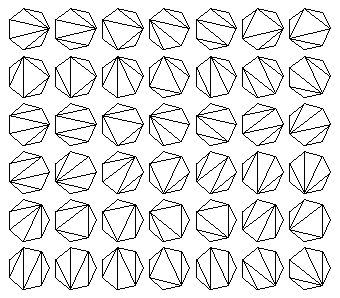
8 sides, 132 ways:
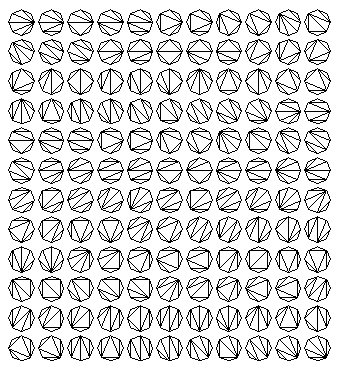
9 sides, 429 ways:
(Hidden in file catalan9.gif; around 29K.)
3 numbers:
(1 (2 3)) ((1 2) 3)4 numbers:
(1 (2 (3 4))) (1 ((2 3) 4)) ((1 2) (3 4)) ((1 (2 3)) 4) (((1 2) 3) 4)5 numbers:
(1 (2 (3 (4 5)))) (1 (2 ((3 4) 5))) (1 ((2 3) (4 5))) (1 ((2 (3 4)) 5)) (1 (((2 3) 4) 5)) ((1 2) (3 (4 5))) ((1 2) ((3 4) 5)) ((1 (2 3)) (4 5)) ((1 (2 (3 4))) 5) ((1 ((2 3) 4)) 5) (((1 2) 3) (4 5)) (((1 2) (3 4)) 5) (((1 (2 3)) 4) 5) ((((1 2) 3) 4) 5)6 numbers:
(1 (2 (3 (4 (5 6))))) (1 (2 (3 ((4 5) 6)))) (1 (2 ((3 4) (5 6)))) (1 (2 ((3 (4 5)) 6))) (1 (2 (((3 4) 5) 6))) (1 ((2 3) (4 (5 6)))) (1 ((2 3) ((4 5) 6))) (1 ((2 (3 4)) (5 6))) (1 ((2 (3 (4 5))) 6)) (1 ((2 ((3 4) 5)) 6)) (1 (((2 3) 4) (5 6))) (1 (((2 3) (4 5)) 6)) (1 (((2 (3 4)) 5) 6)) (1 ((((2 3) 4) 5) 6)) ((1 2) (3 (4 (5 6)))) ((1 2) (3 ((4 5) 6))) ((1 2) ((3 4) (5 6))) ((1 2) ((3 (4 5)) 6)) ((1 2) (((3 4) 5) 6)) ((1 (2 3)) (4 (5 6))) ((1 (2 3)) ((4 5) 6)) ((1 (2 (3 4))) (5 6)) ((1 (2 (3 (4 5)))) 6) ((1 (2 ((3 4) 5))) 6) ((1 ((2 3) 4)) (5 6)) ((1 ((2 3) (4 5))) 6) ((1 ((2 (3 4)) 5)) 6) ((1 (((2 3) 4) 5)) 6) (((1 2) 3) (4 (5 6))) (((1 2) 3) ((4 5) 6)) (((1 2) (3 4)) (5 6)) (((1 2) (3 (4 5))) 6) (((1 2) ((3 4) 5)) 6) (((1 (2 3)) 4) (5 6)) (((1 (2 3)) (4 5)) 6) (((1 (2 (3 4))) 5) 6) (((1 ((2 3) 4)) 5) 6) ((((1 2) 3) 4) (5 6)) ((((1 2) 3) (4 5)) 6) ((((1 2) (3 4)) 5) 6) ((((1 (2 3)) 4) 5) 6) (((((1 2) 3) 4) 5) 6)Tree diagrams:
3 nodes:
![[ again, not much without pictures -- sorry ]](cattree3.gif)
4 nodes:
![]()
5 nodes:

6 nodes:
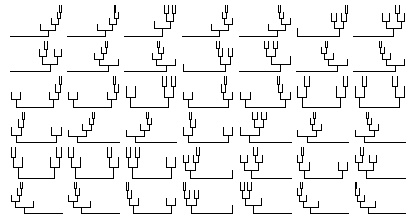
7 nodes:
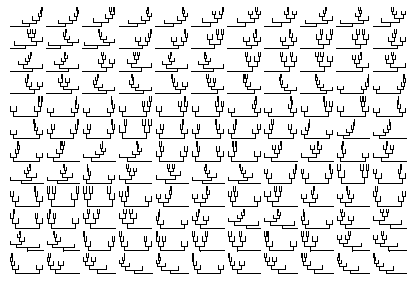
8 nodes:
(Tucked away in file cattree8.gif; around 17K.)
2 x 2 grid:
![[ Again, a picture speaks a thousand etc. ]](catalanpath2.gif)
3 x 3 grid:

4 x 4 grid:

5 x 5 grid:
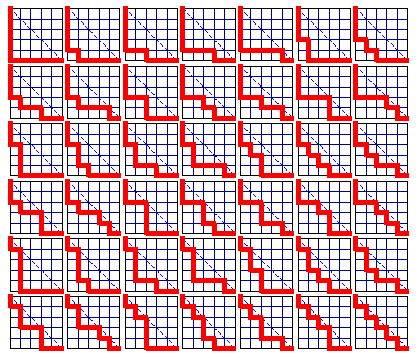
6 x 6 grid:
(Out of the way in file catalanpath6.gif; around 24K.)
Designed and rendered using Mathematica 3.0 for the Apple Macintosh. Inspiration and facts (though not figures) by Brian Hayes, "A Question of Numbers", American Scientist, January-February 1996; Steven S. Skiena, Implementing Discrete Mathematics: Combinatorics and Graph Theory with Mathematica, Addison-Wesley, 1990; Fred S. Roberts, Applied Combinatorics, Prentice-Hall, 1984; and D. E. Knuth, Sorting and Searching (vol. 3 of The Art of Computer Programming), Addison-Wesley, 1973. Catalan dates from Florian Cajori, A History of Mathematics, The Macmillan Company, 1922.
See also Martin Gardner, Time Travel and Other Mathematical Bewilderments, chapter 20, W. H. Freeman, 1988; and Ilan Vardi, Computational Recreations in Mathematica, chapter 9, Addison-Wesley, 1991.
Copyright © 1996 Robert M. Dickau